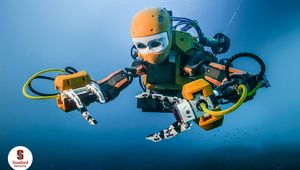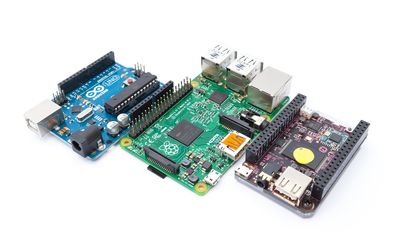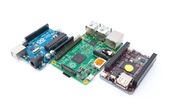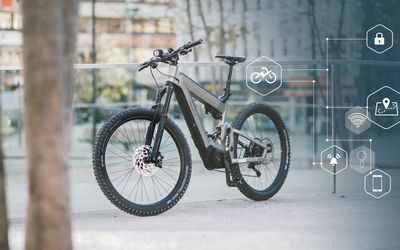Arduino HAT Carrier Board
Carrier Board that transforms Portenta X8, C33, and H7 Series into an industrial single-board computer compatible with Raspberry Pi HATs and cameras.
Technical Specifications
| Compatibility | Raspberry Pi HATs, Arduino Portenta X8, H7, C33 SoMs |
| On-board Peripherals | CAN, Ethernet, microSD and USB |
| Interfaces | CAN FD, UART, SAI, ANALOG, GPIO, SPI, I2C, I2S, PWM |
| Debugging | Onboard 10x pin 1.27mm JTAG connector |
| Operating Temperature | -40 ~ 85 °C |
| Applications | Environmental Monitoring, Smart Building Security, Motion Controllers, Smart Sorting Systems, Audio Quality Test Benches, and Prototyping with Raspberry Pi Hats |
Overview
The Arduino HAT Carrier Board is designed to enhance the capabilities of the Arduino Portenta family, including the Portenta X8, C33 and H7 Series, by offering seamless integration with Raspberry Pi Hats. This integration allows users to expand their projects with additional functionalities such as CAN, Ethernet, microSD, USB, camera, and 16 analog I/Os. The board is specifically tailored for developers looking to create advanced robotics and building automation applications, providing a robust platform that combines the power of the Portenta modules with the versatility of Raspberry Pi Hats.
Arduino HAT Carrier Board Features
The Arduino HAT Carrier Board enhances Arduino Portenta modules by seamlessly integrating with Raspberry Pi HATs. Its standard 40-pin header allows easy attachment of compatible HATs, broadening project capabilities without needing adapters or complex wiring.
The board supports direct communication with industrial equipment through a dedicated CAN bus and provides reliable network access via an onboard Ethernet port. It provides reliable wired network access, essential for internet connectivity, data transfer, and remote monitoring tasks. A dedicated camera connector enables the integration of high-resolution vision systems.
The microSD card slot supports data logging, storage of application libraries, and the flexibility to run different operating systems, adding a layer of versatility to the projects. The board goes beyond the SoM's capabilities by offering extra analog and digital pins for connecting a wider array of sensors and actuators. PWM fan connectors provide fine-grained control over temperature regulation in demanding applications. Users can control actuators or read analog sensors via the additional 16 analog I/Os.
Built with industrial-grade components, the board is reliable and designed to withstand challenging environments. Its compact and lightweight design makes it ideal for smaller projects and prototypes, offering a powerful platform for developers pushing the limits of Portenta modules.
Getting Started with Arduino HAT Carrier Board
Follow these steps to get started with the Carrier Board:
1. Attach the Portenta SoM: Align the SoM with the connector on the HAT Carrier Board and gently press it down until it clicks into place.
2. Connect the power supply: Plug the external power supply into the DC jack on the HAT Carrier Board.
3. Connect the Raspberry Pi HAT: Simply click the HAT onto the standard 40-pin header on the HAT Carrier Board.
4. Connect to your computer: Plug the USB cable into the HAT Carrier Board and your computer.
5. Configure Arduino IDE: In the Arduino IDE, go to Tools > Board and select the board corresponding to your Portenta SoM and HAT Carrier Board combination.
6. Upload your first sketch: Choose a simple example sketch from the Arduino libraries or write your code. Then, click the upload button to send it to the HAT Carrier Board.
Applications
The Arduino HAT Carrier Board supports a wide range of applications from building automation and environmental monitoring to industrial automation, motion controllers, and smart sorting systems. It is particularly useful for developing smart building security systems that require integration of various sensors and actuators. With its analog I/O capabilities, the carrier board also serves as a platform for creating audio-quality test benches. Moreover, it facilitates seamless Linux prototyping by supporting Raspberry Pi Hats, thereby providing an efficient prototyping experience.
Where to find it

Mouser Electronics
Mouser Electronics is a worldwide leading authorized distributor of semiconductors and electronic components.








